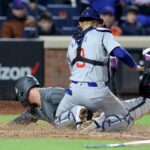In honor of R.A. Dickey’s near no-hitter last night, I decided to dig into our archives and pull out this gem – pitched by Ed Leyro on March 13, 2010. Enjoy reading it!
Every young boy with aspirations of being a major league pitcher dreams of tossing a no-hitter. The thrill of recording out #27 before giving up hit #1 is one of the biggest joys in sports. However, this thrill has never been felt by a New York Mets pitcher.
The Mets are one of four teams to have never pitched a no-hitter. Two of the other three teams are recent expansion teams (Tampa Bay Rays and Colorado Rockies). The other team is the San Diego Padres, who came into existence in 1969.
The closest the Padres came to a no-no was in 1972, when Steve Arlin’s bid was broken up by the Phillies’ Denny Doyle with two outs in the ninth inning. That’s closer than any Mets pitcher has ever come, as no Met hurler in the team’s 48-year history has been within one out of a no-hitter.
Of the 33 one-hitters thrown by Mets pitchers (two of the 33 were of the rain-shortened variety), only two were no-hitters entering the ninth inning. Both were thrown by The Franchise, Tom Seaver, and both were broken up with one out in the ninth inning. Jimmy Qualls of the Chicago Cubs broke up Seaver’s perfect game bid with a one-out single on July 9, 1969 and the Padres’ Leron Lee singled to break up Seaver’s no-hitter on July 4, 1972. Since then, the longest any Mets pitcher has carried a no-hitter is 7 2/3 innings.
Both Tom Glavine and John Maine had their bids for baseball immortality dashed with two outs in the eighth inning. Glavine’s 2004 bid was broken up with a double into the right field corner by Rockies’ catcher Kit Pellow and Maine’s 2007 no-no ended when Marlins’ catcher Paul Hoover hit a slow roller to third reminiscent of the excuse-me single hit by the Cubs’ Keith Moreland to break up Dwight Gooden’s no-hitter in 1984. (Side note: I was present at the Glavine and Maine games. There is no truth to the rumor that I turned to my neighbor and said “do you think we’ll finally see a no-hitter today?” in each game’s eighth inning.)
As seen by the above examples, the Mets have lost no-hitters late in games by hard-hit line drives and little dribblers. But what would be the worst way for the Mets to lose a no-hitter? I believe I may have the answer.
Say Johan Santana is mowing down the Phillies and becomes the first Mets pitcher not named Tom Seaver to take a no-hitter into the ninth inning. (What, did you expect it to be Maine or Perez? Neither of them is capable of pitching into the ninth inning, let alone carrying a no-hitter into the ninth.) Santana retires Jimmy Rollins and Placido Polanco to start the ninth inning, making him the first Mets pitcher to come within one out of a no-hitter.
The next batter is Chase Utley, but he draws a walk. The Phillies now have a baserunner, but the no-hitter is still intact as Ryan Howard steps up to the plate. Howard hits a routine grounder towards Luis Castillo that appears to be the third out of the inning, but the ball hits Utley as he’s running to second base. The umpires immediately call Utley out for being hit by a batted ball in fair territory and the game is over.
Could it be? Has Johan Santana become the first pitcher in Mets history to toss a no-hitter? The players on the field seem to think so, as they’re celebrating with Johan on the mound. But let’s borrow the Major League Baseball Official Rule Book from the official scorer and take a look at two rules.
- Rule 7.08 (f): Any runner is out when he is touched by a fair ball in fair territory before the ball has been touched or passed an infielder. The ball is dead and no runner may score, nor runners advance, except runners forced to advance.
- Rule 10.05 (a) (5): The official scorer shall credit a batter with a base hit when a fair ball that has not been touched by a fielder touches a runner or an umpire, unless a runner is called out for having been touched by an Infield Fly, in which case the official scorer shall not score a hit.
While Johan Santana and his Merry Men were all celebrating his apparent no-hitter, the official scorer noticed that Utley had been called out because he was touched by a fair ball in fair territory before the ball was touched or passed Castillo (Rule 7.08 (f)). By Rule 10.05 (a) (5), the official scorer had to give Ryan Howard a base hit since there was no Infield Fly involved when the ball hit Utley.
Therefore, at the exact moment Johan Santana recorded the 27th out of the game, he also lost his no-hitter. Imagine the shock on his face when the scoreboard flashed the “1” in the hit column. Gary Cohen and Howie Rose would have been sick to their stomachs. If Bob Murphy were still alive, he’d be spinning in his grave while saying “and Santana loses the damn no-hitter”. Ron Darling would have analyzed how losing a no-hitter this way would affect Santana’s psyche and Keith Hernandez would have said that we shouldn’t have female official scorers.
The Mets will pitch a no-hitter…someday. But I wouldn’t be surprised if they lost one in the way detailed above before they actually completed one.













